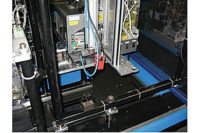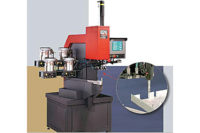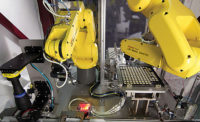Every process change made by a manufacturer brings with it one or more unique challenges. Consider, for example, the challenges involved when switching from manual or pneumatic presses to servo models for low-force-pressing applications.
Some manufacturers continue to use the older models as a backup during the transition, while others use them for less-critical applications. Sensor and electronic-controls manufacturer Sensata Technologies Inc. is taking a completely different approach, thanks to the Smart Function Kit (SMF) from Bosch Rexroth.
For the past year or so, SMF has enabled Sensata to cost-effectively produce 1,000 or 10,000 versions of a sensor in small batches on one assembly line, rather than several. These sensors are used in the manufacturer’s rotary encoders, which determine position and distance in products like self-propelled transport shuttles.
On the assembly line, the sensor’s PCB and disc are placed in a housing and fixed with a lid. The SMF electromechanical cylinder, in turn, quickly, precisely and reliably presses three distance bolts into the housing flange to join both components. The cylinder has a force range from 2 to 30 kilonewtons, with an accuracy of ±0.02 millimeter.
Also included in the kit are a force sensor, a servomotor, a drive controller and an industrial PC with intuitive HMI software. The software performs automatic parameterization of the servo drive, and it also acts as a support wizard to ensure fast, easy commissioning. It is device-independent, runs on any browser and can be operated via tablet.
Separate linear motion software, called LinSelect, helps engineers select and size the correct kit for an application. After the end-user selects the proper-size components, he downloads CAD files for each component and designs the system with an online configurator. This desired configuration is then ordered via the Bosch e-shop, with all components being delivered as one complete package.
A key benefit of SMF for Sensata engineers is being able to use visual programming instead of coding line by line. This involves selecting predefined software blocks and creating a sequential workflow via drag and drop, according to Marc Hubsch, engineering manager in the encoders division at Sensata.
To define the individual processes in the joining procedure, the engineers simply enter the associated parameters. Overall engineering time is reduced by up to 95 percent.
“For monitoring purposes, status information and process results, including a force displacement curve, are shown and recorded live,” says Hubsch. “All data is transferred straight to our IT system, where it is stored and analyzed for quality assurance purposes. This means much greater transparency during production.”
To further simplify line engineering, Sensata operates the XM21 embedded control and TS 2plus modular transfer systems from Bosch Rexroth. The latter system features modules that can be combined in multiple ways to increase manufacturing flexibility.
Looking ahead, Hubsch says Sensata hopes to increase the number of sensor types on the line. There are also plans to duplicate the line and install it at other international sites. Bosch, meanwhile, is looking to further develop the kit’s intuitive software by adding a module for predictive maintenance.
Introduced in 2019, SMFs improve assembly and testing productivity in a wide range of applications. These include press-fitting bearings in housings, crimping cables and hoses, bending and embossing plastic parts, and performing various measurement and test procedures.
For more information, call 800-739-7684 or visit www.boschrexroth.com.













